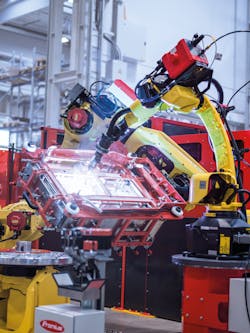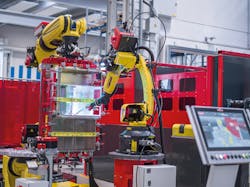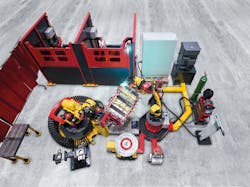Handling To Welding: Two Robots Are All You Need
From steel frames to stainless steel containers and aluminum profiles—metalworking companies producing a wide variety of parts previously needed to rely on part-specific welding systems to take care of different materials, part sizes, and shapes. Fronius Welding has created a solution in aims to streamline welding and handling tasks while reducing equipment needs.
Modular Robot Platform
Fronius developed the Handling-to-Welding robotic welding cell (HTW) solution which enables various tasks to be completed by a single robot cell. Variable system components guarantee smooth processes, and if an intelligent rack storage system is used, inward and outward transport of parts takes place fully automatically. This increases the process autonomy of the entire welding system; instead of using different positioners and welding systems for different components like before, the modular robot cell now performs every welding task, saving time and labor costs.
HTW: Two Robots Working Together
Fronius relies on the cooperation of two robots for its solution. The handling robot grips the workpieces and holds them in position, while the second robot performs the welding. This combination allows for maximum flexibility regarding part and batch sizes as well as seam geometries—even for angular parts.
The Fronius HTW system consists of modules that can be individually assembled. Depending on the cell configuration, part lock gates for inward and outward transport of parts are available. Additionally, various positioners, a Tool Center Point (TCP) measurement system, a torch cleaning system, a gripper station, and a contact tip changing system are also possible. The system is suitable for fully automated welding with the MIG/MAG, CMT (Cold Metal Transfer from Fronius), TIG or plasma processes.
For maximum operating comfort, Fronius has developed a sophisticated set of system controls: the HMI T21-RS allows for monitoring and coordination of all components such as robots, the TPSi power source, positioners, the racking system, and torch cleaning system. A 21-in. touchscreen makes operation quick, easy, and intuitive.
A program editor for defining all program sequences and three-dimensional real-time visualization makes work easier, as both system modules and protected areas are visualized. The standard range of functions includes user and program management, fault message displays, cycle, and part counters, language options, system status displays, and power management (electrical supply) of all components.
Fronius Pathfinder software makes the modular HTW welding cell even more efficient. Previously, ongoing welding work had to be finished first before the next program could be programmed. Pathfinder now enables the new welding process to be programmed during ongoing operation—and offline too. In other words, programming can be carried out away from the robotic welding cell. The software recognizes axis limits, calculates start points, endpoints, approach paths, and independently sets teach points. Interference contours can be visualized and torch positions corrected promptly. In addition, the whole process is performed in advance and not during initial welding tests, which saves additional time and costs.
The Complete Concept
The modular HTW robotic welding cell consists of the following components:
- Handling and welding robots
- Robot control for handling and welding robots
- Fronius TPS/i Robotics power source with integrated robot interface
- HMI T21-RS system controls including 3D real-time display and welding data documentation
- Welding torch systems suitable for all welding processes and component geometries
- Cleaning, measuring, and changing station for welding torches and contact tips
- Optional: racking systems and changing station for positioners
This welding solution becomes a complete concept not only through its sophisticated, coordinated hardware and software components but comprehensive customer service also plays a key role. On request, Fronius can provide support in advance with feasibility studies, design, simulation of all processes, and user training. The dense Fronius service network is also extremely reliable, with help always readily available around the world.



